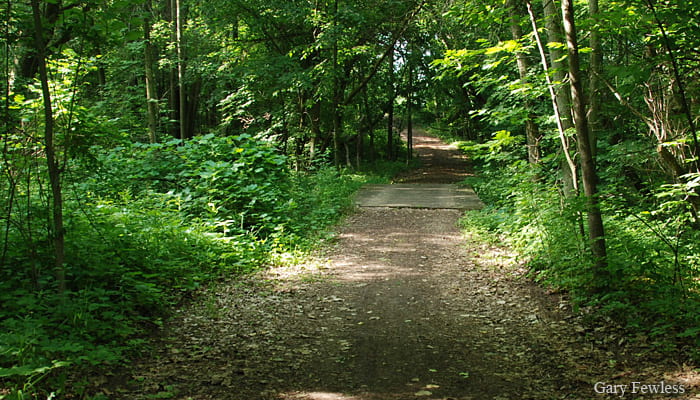Are you trying to decide between working out at the gym and taking a walk in the woods? If you are interested in improving your mental, as well as your physical health, new research recommends heading for the woods.

Most people would probably agree that a walk in the woods (barring mosquitoes) has a reviving effect on our mental well-being. Writers, from Pliny to Thoreau, have touted the recuperative benefits of nature. Frederick Law Olmsted, the Landscape Architect who founded The Clearing, located in Door County, WI, wrote in 1865 “the enjoyment of scenery employs the mind without fatigue and yet exercises it; tranquilizes it and yet enlivens it; and thus, through the influence of the mind over the body, gives the effect of refreshing rest and reinvigoration to the whole system.” In 1985 E. O. Wilson explored this love of nature in his book “Biophilia”. In it he championed the idea that our attraction to nature goes beyond the aesthetic to the genetic, that our love of nature is actually genetically programmed.
A new study led by Richard Mitchell of the Centre for Research on Environment, Society and Health, at Glasgow University agrees with Wilson’s assertion. They looked at the locations that 1800 physically active people chose for exercise and then compared that data to measures of their mental health. Interestingly, only activity in the natural environment was associated with a lower risk of poor mental health. Those that chose to exercise in woodlands or parks had a 50% greater effect on positive mental health compared to those who chose the gym. The study also indicates that the positive effects of activity in a natural area cause a physiological change that goes beyond the effect of positive thought. Our biology actually changes when we experience nature.
There have been a number of theories that have been proposed to try to explain the physiological beneficial influence of nature, but probably the two best-known theories are the Attention Restoration Theory of Kaplan and Kaplan (1989) and the psycho-evolutionary theory developed by Ulrich and his colleagues in the 1990s. These theories explain the influence of nature, especially plants, on the reduction of stress and mental fatigue. Both theories consider the recovery effects of viewing nature to have a biological cause.
Attention restoration theory suggests that fatigue caused by trying to concentrate on a project in the face of continued distractions can be restored by quiet exercise and reflection in a natural environment. It is based on the assumption that natural settings are “quietly fascinating” and draw our attention without our even realizing it. We observe nature in a way that requires no effort, and is pleasing because it creates a sense of order and meaning. However, watching nature is not so attention grabbing that it prevents the reflective thought that allows us to recover from mental fatigue. Natural settings, they argue, also reduce stress because they create a feeling of “getting away” or escaping from the work environment.
Another theory, developed by Ulrich and Parson in the 1990s, argues that our modern world is over-stimulating because it is too visually complex and loud. They argue that natural settings reduce stress because they mimic the natural habitats that we evolved in. We are drawn to and have a positive psychological response to natural settings like woodland edges, grassy meadows and ponds and stream edges. Visiting natural spaces like the Cofrin Arboretum or other natural areas speeds recovery from stress.
Other studies agree with the results reached by Mitchell and his colleagues. Studies by several Japanese researchers have shown that forest walks result in lower blood pressure, pulse rates and cortisol levels, as well as increased heart healthy hormones. A study by Jo Barton and Jules Pretty in 2010 determined that spending just five minutes walking in an outdoor natural setting caused improved mental and emotional health. A study by Roe and Aspinall (2010) found that rural walks had a more restorative effect on mental health than urban walks did. They also found that those with poorer mental health saw even greater restorative effect from walking in a rural landscape. In a different study they found that when children with extreme behavior problems spent time in forest settings, they developed positive emotional responses, like improved trust, over time (Roe and Aspinall 2011).
What is the take home message? Go take a walk in the woods. Nature can help those of us that live and work in complex stressful environments to be physiologically healthier if we take the time to visit natural areas to de-compress. There is a positive biological effect on your body when you experience trees, vegetation, streams and ponds.
Four of UW—Green Bay’s natural areas, The Cofrin Arboretum, Point au Sable, Kingfisher Farm, and Toft Point, provide walking trails. Plan your next walk outside and enjoy the benefits of greater health!
Links:
- Regular exercise in natural environments halves risk of poor mental health: http://www.gla.ac.uk/news/headline_236113_en.html
- Barton, J. and Pretty, J. (2010) What is the Best Dose of Nature and Green Exercise for Improving Mental Health? A Multi-Study Analysis. Environ. Sci. Technol., 2010, 44 (10), pp 3947–3955
- R. Kaplan and S. Kaplan. (1989) The experience of nature: A psychological perspective. New York: Cambridge University Press.
- Roe, J. and Aspinall, P. (2011): The restorative benefits of walking in urban and rural settings in adults with good and poor mental health, Health & Place 17, 103-113
- Roe, J. and Aspinall, P. (2011): The emotional affordances of forest settings: an investigation in boys with extreme behavioural problems. Landscape Research.
- Ulrich, Roger S., Robert F. Simons, Barbara D. Losito, Evelyn Fiorito, Mark A. Miles, and Michael Zelson. 1991. Stress recovery during exposure to natural and urban environments. Journal of Environmental Psychology 11: 201-230.
- Wilson, Edward O. (1984). Biophilia. Cambridge: Harvard University Press.
